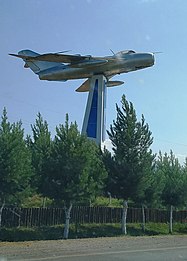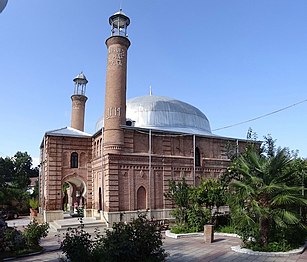Qazax
Coordinates: 41°05′36″N 45°21′58″E / 41.09333°N 45.36611°E
Qazax | |
|---|---|
City & Municipality | |
 Qazax | |
| Coordinates: 41°05′36″N 45°21′58″E / 41.09333°N 45.36611°E | |
| Country | |
| District | Qazax |
| Established | 1909 |
| Area | |
| • Total | 10 km2 (4 sq mi) |
| Elevation | 381 m (1,250 ft) |
| Population | |
| • Total | 35,102 |
| • Density | 3,500/km2 (9,100/sq mi) |
| Time zone | UTC+4 (AZT) |
| Area code(s) | +994 2229 |
Qazax (anglicized as Gazakh) ![]() (listen)) is a city in and the capital of the Qazax District of Azerbaijan. It has a population of 20,900.[2]
(listen)) is a city in and the capital of the Qazax District of Azerbaijan. It has a population of 20,900.[2]
History[]
Early history[]
In antiquity, the territory of the modern Qazax District was part of the province of Utik, a part of the Kingdom of Armenia until 387 AD. Greco-Roman historians from the 2nd century BC to the 4th century AD state that Utik was a province of Armenia, with the Kura River separating Armenia and Caucasian Albania.[3][4][5]
In the 17-18th century, Qazax was the capital of the Kazakh Sultanate. During the Russian Empire, the city was the administrative center of the Kazakh Uyezd of the Elisabethpol Governorate. It is situated 10 km from the Ağstafa station of the Transcaucasus Railway.
Conflicts and disputes with Armenia[]
Qazax was a plurality Armenian city as late as 1897.[6]
From 1905 to 1906, during the Armenian–Tatar massacres, many Armenian homes were burned and looted by Azerbaijanis, as well as the Armenian school and church. Many Armenian inhabitants as a result fled to Tbilisi and other nearby Armenian-populated areas.[7]
From an Armenian perspective, these territories were historical Armenian provinces—which had been, factually, incorporated in various Armenian states—and therefore, the Qazax region was initially contested between the Armenian and Azerbaijani SSRs.[8] The Armenian name for the city is Ghazakh (Armenian: Ղազախ, romanized: Ġazax),[9] and it is based on the Azerbaijani name itself.
When the South Caucasus came under British occupation, Sir John Oliver Wardrop, British Chief Commissioner in the South Caucasus, decided that assigning the Erivan Governorate and the Kars Oblast to Democratic Republic of Armenia (DRA) and the Elisabethpol and Baku Governorates to the Azerbaijan Democratic Republic (ADR) would solve the region's outstanding disputes. However, this proposal was rejected by both Armenians (who did not wish to give up their claims to Qazax, Syunik, and Nagorno-Karabakh) and Azerbaijanis (who did not wish to give up their claims to Nakhchivan). As conflict broke out between the two groups, the British left the region in mid-1919.[10]
In 1930, Qazax became the administrative center of Azerbaijan's Qazax District. The area has major strategic importance for modern-day Azerbaijan-Georgia-Turkey regional communication and energy projects.[dubious ]
Modern history[]
During the First Nagorno-Karabakh War, Armenian troops took control of several villages of the Qazax district. Several Azerbaijani inhabitants were killed during the war, others were able to flee.[11][12]
In July 2020, Qazax became a site for clashes with Armenia.[13]
Demographics[]
| Year | Total population | Armenians | Azerbaijanis (then called Tatars) | Russians, Ukrainians, and Belorussians | Georgians | Greeks | Poles | Others (Avars, Lithuanians, Germans, Jews, and Tats) |
|---|---|---|---|---|---|---|---|---|
| 1897[14][15] | 1 769 | 802 (45.3 %) | 601 (34 %) | 251 (14.19 %) | 60 (3.39 %) | 19 (1.07 %) | 11 (0.62 %) | 23 (1.3 %) |
According to the "Caucasian Calendar", the population of the city in 1907 was 732 people, primarily Armenians with Azerbaijanis as a minority (in the source as "Tatars"), and by 1910, the population was 1,050 people.[6]
According to the 1926 census of the USSR, 6,767 people lived in the city.[16]
In 1970, the city was home to about 13,000 people,[17] in 1991, that number was about 19,300 people.[17]
By 2013, there were about 21,000 people living in Qazax (10,200 men and 10,800 women).[18]
The main occupations of the population are carpet making[19] and horse breeding (specifically the Deliboz breed).[20]
Economy[]
This section needs expansion. You can help by . (November 2014) |
The economy of Qazax is partially agricultural, partially tourism-based, with some industries in operation.

The Qazax Cement Plant is served by a railway branch off the BTK railway at Agstafa.
Culture[]
This section needs expansion. You can help by . (November 2014) |
A memorial museum dedicated to Molla Panah Vagif and Molla Vali Vidadi is located in the city.
Sports[]
The city has one professional football team, Göyazan Qazakh, currently competing in the second-flight of Azerbaijani football, the Azerbaijan First Division.
Transport[]
Public transport[]
Qazakh has a large urban transport system, mostly managed by the Ministry of Transportation.
Notable natives[]
Some of the city's many prestigious residents include: poets Samad Vurgun, Molla Panah Vagif, Mirvarid Dilbazi and Nusrat Kasamanli, scholar Molla Vali Vidadi, lieutenant-general of the Russian imperial army Ali-Agha Shikhlinski, writer Ismayil Shykhly and wrestler Hasan Aliyev.

Samad Vurgun, one of the prominent poets in Azerbaijani literature.

Mirvarid Dilbazi, poet.

Farrukh Gayibov, considered to be the first Azerbaijani pilot.

Samad aga Agamalioglu, was a statesman and socialist revolutionary.[21]
Gallery[]

Monument for memory of Farrukh Gayibov

Qazakh mosque
References[]
- ^ The state statistical committee of the Azerbaijan Republic Archived November 14, 2010, at the Wayback Machine
- ^ [1]
- ^ Strabo, Geography, 11.14.4, http://www.perseus.tufts.edu/cgi-bin/ptext?doc=Perseus:text:1999.01.0198&loc=11.14.1 Archived 2012-12-12 at archive.today
- ^ Pliny the Elder, "The Natural history ", 6.39: "..the tribe of Albanians settled on the Caucasian mountains, reaches ... the river Kir making border of Armenia and Iberia"
- ^ Claudius Ptolemy, "Geography" 5.12: "Armenia is located from the north to a part of Colchida, Iberia and Albania along the line, which goes through the river Kir (Kura)"
- ^ Jump up to: a b "Кавказский календарь. — Тифлис, 1912". pp. с. 160.
- ^ Ա-Դօ (A-Do), Հայ-թուրքական ընդհարումները Կովկասում (1905-1906 թ.) (Armenian-Turkish conflicts in the Caucasus of 1905–1906), Yerevan, 1907, p. 360
- ^ Dr. Andrew Andersen, PhD Atlas of Conflicts: Armenia: Nation Building and Territorial Disputes: 1918–1920
- ^ Karapetyan, Samvel (2007). Northern Artsakh. Yerevan: HH GAA "Gitutʻyun publishing-house of the NAS RA. pp. 435–454. ISBN 5-8080-0677-5. OCLC 506641072.
- ^ Dr. Andrew Andersen, PhD Atlas of Conflicts: Armenia: Nation Building and Territorial Disputes: 1918–1920
- ^ "Армения - Азербайджан: Это уже просто война" (in Russian). Журнал «Власть». 20 August 1990.
- ^ "Ermənistan-Azərbaycan, Dağlıq Qarabağ münaqişəsi nəticəsində Qazax rayonunda hərbi təcavüzün nəticələri barədə MƏLUMAT". www.qazax-ih.gov.az. KAZAKH DISTRICT EXECUTIVE AUTHORITY OF THE REPUBLIC OF AZERBAIJAN. 3 December 2020. Retrieved 3 December 2020.
Xocalı soyqırımında olduğu kimi Qazax rayonunun Bağanıs Ayrım kəndində Dədəş Əsliyevin 4 nəfərdən ibarət ailə üzvü və 3 nəfər kənd sakini ermənilər tərəfindən diri-diri yandırılmışdır.
- ^ Harutyunyan, Sargis; Danielyan, Emil. "Armenia-Azerbaijan Border 'Calm' After Deadly Clashes". azatutyun.am. RFE/RL. Archived from the original on 5 August 2020. Retrieved 5 August 2020.
...the border between Armenia’s northern Tavush province and the Tovuz district in Azerbaijan, the scene of the clashes.
- ^ Первая Всеобщая перепись населения Российской империи 1897 г./ под ред. (и с предисл. Н.А. Тройницкого). - Санкт-Петербург: издание Центрального статистического комитета Министерства внутренних дел , 1899-1905. Елисаветпольская губерния. - 1904. - 4, XII, 184 с. Стр. VII, 1-3.
- ^ Первая всеобщая перепись населения Российской Империи 1897 г. Распределение населения по родному языку и уездам Российской Империи кроме губерний Европейской России. Казах
- ^ Всесоюзная перепись населения 1926 г. Казахский уезд
- ^ Jump up to: a b Казах — статья из Большой советской энциклопедии
- ^ Данные Государственного статистического комитета Азербайджанской Республики на 2013 год
- ^ "Ковроткачество в Азербайджане" (PDF).
- ^ "Город Газах (Азербайджан)" (in Russian). geogoroda.ru. 2016-06-12. Retrieved 2018-09-30.
- ^ "Brian C. Collins, Historical dictionary of Azerbaijan, USA, Scarecrow Press, 1999". Archived from the original on 2017-04-06. Retrieved 2016-11-05.
External links[]
- Populated places in Qazakh District
- Elisabethpol Governorate
- 1909 establishments in Azerbaijan








